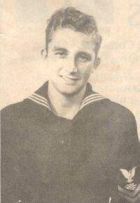Source:
Letter from E. C. "Buddy" Porterfield to the
USS SLC CA25 Association Newsletter- May 2001
On November 13, 1940, I left Dallas, TX., on a long train ride to San
Diego, CA. to begin my service in the United States Navy. I didn't know
when I enlisted that I would be participating in one of the most
significant times of our nation's history in this century. After my
service at Boot camp, I spent 16 weeks in Radio School. After a short
leave at home, I returned to San Diego to work the teletype between
Washington and San Diego, sending and receiving messages.
Orders then sent me to San Francisco and on to Pearl Harbor to wait for
the "Salt Lake City" to arrive. I transferred to the "Salt Lake City" as
a General Service Radioman. After a few days, we loaded up with stores
and fuel and set sail to rendezvous with the Dutch ship, the Jagars
Fontaine. We escorted her across the 180th meridian at the equator,
which made us golden shellbacks. We later ran into a Japanese fishing
fleet and turned back because we had a treaty with Japan that we would not
cross the International Date Line with anything larger than 9,000 tons and
we were over 10,000 tons. We broke off and went down to Brisbane,
Australia. Coming back we charted a lot of the water that had not been
charted around Guadalcanal. When we returned to Pearl, we picked up the
"USS Enterprise" with 18 Marine Pilot planes aboard and escorted them to
Wake Island. On the way back, the Japs were right behind us. They
somehow missed us and came in and attacked Pearl Harbor.
April, 1942, the "Salt Lake City" escorted the "Hornet" and the
"Enterprise" Group Task Force 16, to within 500 miles of the Japanese
mainland to launch Lt. Col.
Doolittle's raids on Tokyo and other Japanese cities.
We did not know that by March, 1943, we would be engaged in the longest
sea engagement of the war - The Battle of the Komandorski Islands. In
that battle, shrapnel split my steel helmet and bounce to hit

 Don Rholl
in the leg. We were a
bunch of very young men who had to learn our jobs and work as a team amid
circumstance that were both frightening and critical to our nation's
defense.
Don Rholl
in the leg. We were a
bunch of very young men who had to learn our jobs and work as a team amid
circumstance that were both frightening and critical to our nation's
defense.
After emerging from extensive repairs at Mare Island, we went south to
Wotje. One of our pilots was

 Martin
Dana,
a good pilot who had been an instructor in Jacksonville,
Fla. I rode rear cockpit with him. Japs had been bombarding the Island,
and we had a call that a Navy fighter was down. Dana and I flew out. We
saw him in the water and threw down a flare. Dana landed, I got the pilot
into the rear cockpit, threw out my parachute and machine gun to reduce
fuel consumption, and we made it back to the Salt Lake. I proudly received
the US Air Medal Award.
Martin
Dana,
a good pilot who had been an instructor in Jacksonville,
Fla. I rode rear cockpit with him. Japs had been bombarding the Island,
and we had a call that a Navy fighter was down. Dana and I flew out. We
saw him in the water and threw down a flare. Dana landed, I got the pilot
into the rear cockpit, threw out my parachute and machine gun to reduce
fuel consumption, and we made it back to the Salt Lake. I proudly received
the US Air Medal Award.
In November, 1943, the "Salt Lake City" supported the Marines in the
famous conquest of Tarawa. The Jap shore battery fired on us for almost
two hours and never made a hit. The "Salt Lake City" took three of their
planes in a torpedo attack.
When I left the "Salt Lake City" for Alameda, CA. I was assigned to
Millington and went to school to be an instructor. I taught Electronics
at the Officers Communications School until my discharge as Aviation Chief
Radioman in November, 1946.
LaVerne and I were so happy to come on board the "Salt lake City Reunion"
in the 1980's. It seems many of you thought I had been killed in the war.
We enjoyed many wonderful reunions with you.
Thanks for the memories,
Ernest C. "Buddy" Porterfield
|

 Ernest Carroll "Buddy" Porterfield passed away on January 8th, 2002
Ernest Carroll "Buddy" Porterfield passed away on January 8th, 2002